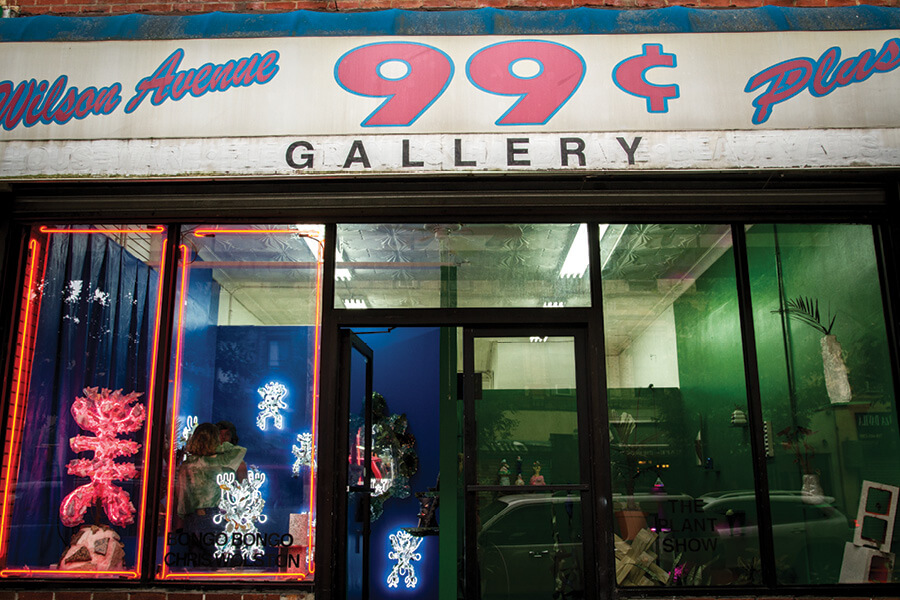Handjob Gallery: Where Art and Design Meet in Bushwick
Historically, handmade objects that cross the threshold of art and design have not been considered, well, art. If a good-looking thing had a function, then art it was not.
Yet, the premise that something must be useless in order to be valued seems limiting. Zoe Alexander Fisher, founder of Handjob Gallery in Bushwick, thought so, too. We stopped by the space early in August to meet Fisher, and learn more about what she has done to change people’s perception of how useful things can enter the inscrutable and often frustrating world of fine art.
“I wanted artists to experience and think of new forms of functionality,” Fisher explained of her impetus to start Handjob directly out of her sculpture and studio arts program at Sarah Lawrence. While there, she wrote a thesis on the same topic. “What I found through writing this is that functionality is a very simple definition between art and design,” she said. “Not very many people were comfortable with that crossover.”
Fisher wore stone-washed vintage skinny jeans, yellow suede heels, and a sheer green blouse that matched a hue of lime painted on the gallery wall. Even this fantastic assemblage—her outfit—seemed, to me, like art with an obvious function.
The first iteration of Handjob launched in a Sight Unseen space in SoHo in 2013. She reached out to artists who had either been experimenting in the art-to-design crossover, or who, conceptually, would be interested in trying it out. Handjob launched with 20 artists who made editions of five to ten objects—the same one or versions of the same one—with their hands, and with the artists’ own definition of functional.
“It also was a way to provide alternative incomes for artists that are super conceptual, or whose paintings sell for $20 thousand every once in a while,” Fisher explained. Handjob’s first iteration doubled as a store. “This is a way you could sell an edition of five to ten things for under $400.”


In 2014, Fisher settled into Handjob’s current Bushwick space, an old 99 cent store that is next to a flower shop, run by a family with four daughters. Fisher takes them to the beach each summer. “We love our block, we’ve been here for three years. OUTLET gallery is across the street, and the flower shop, we are best friends with the whole family,” says Fisher. “And that makes it really meaningful for us to be here.”
In June, Fisher discontinued Handjob’s retail shop and created within it two gallery spaces. One side of the room is called Handjob, which fisher will curate, and the other is 99¢ Plus, another space co-founded with Simran Johnston and Riley Strom. Meanwhile, Handjob art and design objects are still for sale online.
As a gallery, says Fisher, she can give artists more shelf space, inviting them to transform a whole room, versus giving them a little section on a shelf to display their inventory. Surrounding us in 99¢ Plus was a show inspired by plants called, simply, “The Plant Show.” Artists were asked to design something that brought plant life into the home. In the center of the room, artist Cody Hoyt had constructed interconnected wooden blocks, resembling something like a Jenga tower. A robust green plant crowned the top of it.
“Even higher-end galleries are approaching art and design a little more loosely now,” says Fisher. “So artists can make a lot of cool stuff, like this neon,” she gestures to an alluring neon lamp by artist Chris Wolston. “Maybe I’ll buy a fucking crazy neon lamp rather than go to Ikea,” said Fisher, of a hypothetical buyer. “This stuff is more expensive—but not much. It’s still affordable.”
Now, Fisher says the pressing need she felt to create an art and design space no longer exists. People are more comfortable letting those worlds hang out together. But after all the chafing against it, what finally changed minds? Like many things, Fisher says, it was the Internet.
“Digital art and new media was detached from physical reality, and a lot of artists were like, ‘Fuck this, I wanna use my hands,’” said Fisher, standing near the large front window at Handjob. That, in turn, started to re-energize interest handicrafts like ceramics. “A huge part of it comes from how much time we spend staring at a screen; a big part of it is how much we want to use our hands, making things we can use every day.” ♦
Photos by Jane Bruce
You might also like 




















